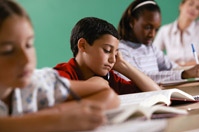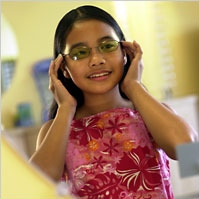School-aged Vision: 6 to 18 Years of Age
- Vision Skills Needed for School Success
- Signs of Eye and Vision Problems
- When is a Vision Exam Needed?
- Sports Vision and Eye Protection
 The school years are a very important time in every child's life. All parents want to see their children do well in school and most parents do all they can to provide them with the best educational opportunities. But too often one important learning tool may be overlooked - a child's vision.
The school years are a very important time in every child's life. All parents want to see their children do well in school and most parents do all they can to provide them with the best educational opportunities. But too often one important learning tool may be overlooked - a child's vision.As children progress in school, they face increasing demands on their visual abilities. The size of print in schoolbooks becomes smaller and the amount of time spent reading and studying increases significantly. Increased class work and homework place significant demands on the child's eyes. Unfortunately, the visual abilities of some students aren't performing up to the task.
When certain visual skills have not developed, or are poorly developed, learning is difficult and stressful, and children will typically:
- Avoid reading and other near visual work as much as possible.
- Attempt to do the work anyway, but with a lowered level of comprehension or efficiency.
- Experience discomfort, fatigue and a short attention span.
Because vision may change frequently during the school years, regular eye and vision care is important. The most common vision problem is nearsightedness or myopia. However, some children have other forms of refractive error like farsightedness and astigmatism. In addition, the existence of eye focusing, eye tracking and eye coordination problems may affect school and sports performance.
Eyeglasses or contact lenses may provide the needed correction for many vision problems. However, a program of vision therapy may also be needed to help develop or enhance vision skills.
Vision Skills Needed For School Success
Vision is more than just the ability to see clearly, or having 20/20 eyesight. It is also the ability to understand and respond to what is seen. Basic visual skills include the ability to focus the eyes, use both eyes together as a team, and move them effectively. Other visual perceptual skills include:- recognition (the ability to tell the difference between letters like "b" and "d"),
- comprehension (to "picture" in our mind what is happening in a story we are reading), and
- retention (to be able to remember and recall details of what we read).
- Visual acuity — the ability to see clearly in the distance for viewing the chalkboard, at an intermediate distance for the computer, and up close for reading a book.
- Eye Focusing — the ability to quickly and accurately maintain clear vision as the distance from objects change, such as when looking from the chalkboard to a paper on the desk and back. Eye focusing allows the child to easily maintain clear vision over time like when reading a book or writing a report.
- Eye tracking — the ability to keep the eyes on target when looking from one object to another, moving the eyes along a printed page, or following a moving object like a thrown ball.
- Eye teaming — the ability to coordinate and use both eyes together when moving the eyes along a printed page, and to be able to judge distances and see depth for class work and sports.
- Eye-hand coordination — the ability to use visual information to monitor and direct the hands when drawing a picture or trying to hit a ball.
- Visual perception — the ability to organize images on a printed page into letters, words and ideas and to understand and remember what is read.
[back to top]
Signs of Eye and Vision Problems
A child may not tell you that he or she has a vision problem because they may think the way they see is the way everyone sees.Signs that may indicate a child has vision problem include:
- Frequent eye rubbing or blinking
- Short attention span
- Avoiding reading and other close activities
- Frequent headaches
- Covering one eye
- Tilting the head to one side
- Holding reading materials close to the face
- An eye turning in or out
- Seeing double
- Losing place when reading
- Difficulty remembering what he or she read
When is a Vision Exam Needed?
 Unfortunately, parents and educators often incorrectly assume that if a child passes a school screening, then there is no vision problem. However, many school vision screenings only test for distance visual acuity. A child who can see 20/20 can still have a vision problem. In reality, the vision skills needed for successful reading and learning are much more complex.
Unfortunately, parents and educators often incorrectly assume that if a child passes a school screening, then there is no vision problem. However, many school vision screenings only test for distance visual acuity. A child who can see 20/20 can still have a vision problem. In reality, the vision skills needed for successful reading and learning are much more complex.Even if a child passes a vision screening, they should receive a comprehensive optometric examination if:
- They show any of the signs or symptoms of a vision problem listed above.
- They are not achieving up to their potential.
- They are minimally able to achieve, but have to use excessive time and effort to do so.
[back to top]
Sports Vision and Eye Protection
Outdoor games and sports are an enjoyable and important part of most children's lives. Whether playing catch in the back yard or participating in team sports at school, vision plays an important role in how well a child performs.Specific visual skills needed for sports include:
- Clear distance vision
- Good depth perception
- Wide field of vision
- Effective eye-hand coordination
Eye protection should also be a major concern to all student athletes, especially in certain high-risk sports. Thousands of children suffer sports-related eye injuries each year and nearly all can be prevented by using the proper protective eyewear. That is why it is essential that all children wear appropriate, protective eyewear whenever playing sports. Eye protection should also be worn for other risky activities such as lawn mowing and trimming.
Regular prescription eyeglasses or contact lenses are not a substitute for appropriate, well-fitted protective eyewear. Athletes need to use sports eyewear that is tailored to protect the eyes while playing the specific sport. Your doctor of optometry can recommend specific sports eyewear to provide the level of protection needed.
It is also important for all children to protect their eyes from damage caused by ultraviolet radiation in sunlight. Sunglasses are needed to protect the eyes outdoors and some sport-specific designs may even help improve sports performance.
[back to top]
